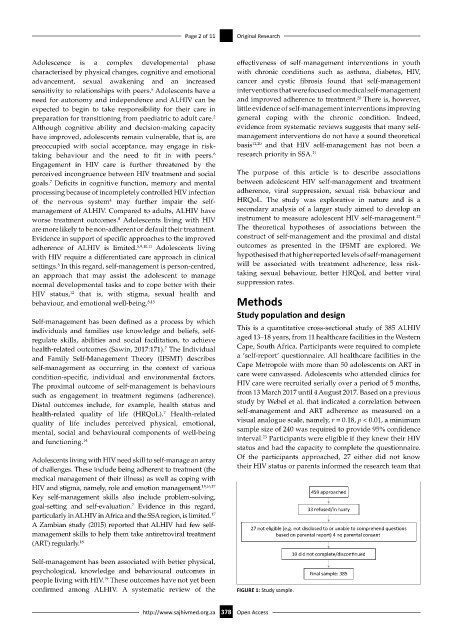Page 386 - HIVMED_v21_i1.indb
P. 386
Page 2 of 11 Original Research
Adolescence is a complex developmental phase effectiveness of self-management interventions in youth
characterised by physical changes, cognitive and emotional with chronic conditions such as asthma, diabetes, HIV,
advancement, sexual awakening and an increased cancer and cystic fibrosis found that self-management
6
sensitivity to relationships with peers. Adolescents have a interventions that were focused on medical self-management
20
need for autonomy and independence and ALHIV can be and improved adherence to treatment. There is, however,
expected to begin to take responsibility for their care in little evidence of self-management interventions improving
preparation for transitioning from paediatric to adult care. general coping with the chronic condition. Indeed,
2
Although cognitive ability and decision-making capacity evidence from systematic reviews suggests that many self-
have improved, adolescents remain vulnerable, that is, are management interventions do not have a sound theoretical
preoccupied with social acceptance, may engage in risk- basis 12,20 and that HIV self-management has not been a
6
taking behaviour and the need to fit in with peers. research priority in SSA. 21
Engagement in HIV care is further threatened by the
perceived incongruence between HIV treatment and social The purpose of this article is to describe associations
goals. Deficits in cognitive function, memory and mental between adolescent HIV self-management and treatment
7
processing because of incompletely controlled HIV infection adherence, viral suppression, sexual risk behaviour and
of the nervous system may further impair the self- HRQoL. The study was explorative in nature and is a
4
management of ALHIV. Compared to adults, ALHIV have secondary analysis of a larger study aimed to develop an
22
8
worse treatment outcomes. Adolescents living with HIV instrument to measure adolescent HIV self-management.
are more likely to be non-adherent or default their treatment. The theoretical hypotheses of associations between the
Evidence in support of specific approaches to the improved construct of self-management and the proximal and distal
adherence of ALHIV is limited. 5,9,10,11 Adolescents living outcomes as presented in the IFSMT are explored. We
with HIV require a differentiated care approach in clinical hypothesised that higher reported levels of self-management
settings. In this regard, self-management is person-centred, will be associated with treatment adherence, less risk-
5
an approach that may assist the adolescent to manage taking sexual behaviour, better HRQoL and better viral
normal developmental tasks and to cope better with their suppression rates.
12
HIV status, that is, with stigma, sexual health and
behaviour, and emotional well-being. 5,13 Methods
Study population and design
Self-management has been defined as a process by which
individuals and families use knowledge and beliefs, self- This is a quantitative cross-sectional study of 385 ALHIV
regulate skills, abilities and social facilitation, to achieve aged 13–18 years, from 11 healthcare facilities in the Western
health-related outcomes (Sawin, 2017:171). The Individual Cape, South Africa. Participants were required to complete
7
and Family Self-Management Theory (IFSMT) describes a ‘self-report’ questionnaire. All healthcare facilities in the
self-management as occurring in the context of various Cape Metropole with more than 50 adolescents on ART in
condition-specific, individual and environmental factors. care were canvassed. Adolescents who attended clinics for
The proximal outcome of self-management is behaviours HIV care were recruited serially over a period of 5 months,
such as engagement in treatment regimens (adherence). from 13 March 2017 until 4 August 2017. Based on a previous
Distal outcomes include, for example, health status and study by Webel et al. that indicated a correlation between
health-related quality of life (HRQoL). Health-related self-management and ART adherence as measured on a
7
quality of life includes perceived physical, emotional, visual analogue scale, namely, r = 0.18, p < 0.01, a minimum
mental, social and behavioural components of well-being sample size of 240 was required to provide 95% confidence
23
and functioning. 14 interval. Participants were eligible if they knew their HIV
status and had the capacity to complete the questionnaire.
Of the participants approached, 27 either did not know
Adolescents living with HIV need skill to self-manage an array
of challenges. These include being adherent to treatment (the their HIV status or parents informed the research team that
medical management of their illness) as well as coping with
HIV and stigma, namely, role and emotion management. 15,16,17 459 approached
Key self-management skills also include problem-solving,
goal-setting and self-evaluation. Evidence in this regard, 33 refused/in hurry
7
particularly in ALHIV in Africa and the SSA region, is limited.
17
A Zambian study (2015) reported that ALHIV had few self- 27 not eligible (e.g. not disclosed to or unable to comprehend ques ons
management skills to help them take antiretroviral treatment based on parental report) 4 no parental consent
(ART) regularly. 18
10 did not complete/discon nued
Self-management has been associated with better physical,
psychological, knowledge and behavioural outcomes in Final sample: 385
people living with HIV. These outcomes have not yet been
19
confirmed among ALHIV. A systematic review of the FIGURE 1: Study sample.
http://www.sajhivmed.org.za 378 Open Access

